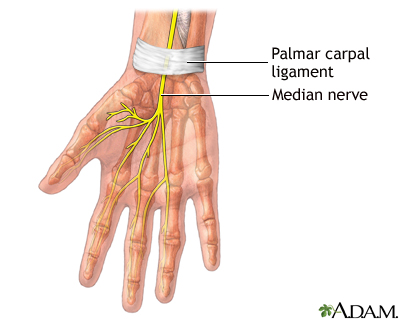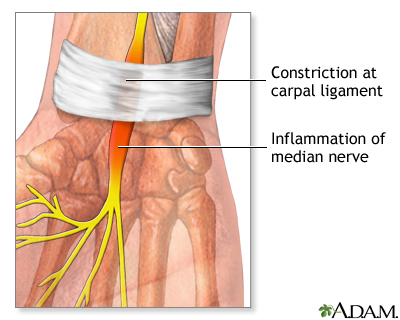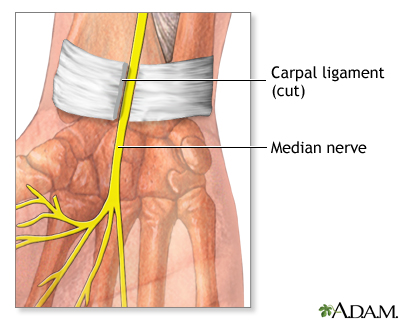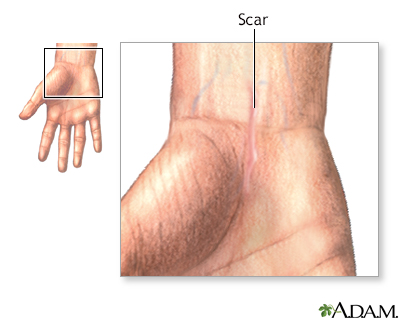Carpal tunnel release
Carpal tunnel release is surgery to treat carpal tunnel syndrome. Carpal tunnel syndrome is pain, numbness, and weakness in the hand that is caused by pressure on the median nerve in the wrist.
Carpal tunnel syndrome
Carpal tunnel syndrome is a condition in which there is excessive pressure on the median nerve at the wrist. This is the nerve that allows feeling a...

Description
Video Transcript
Carpal tunnel syndrome - Animation
Typing all day on a computer keyboard can be tough on your wrists. If you type for hours at a time, day after day, eventually you may really start to feel some discomfort. The numbness, pain, and tingling you feel in your hands and wrists may be carpal tunnel syndrome, and it can have such a big effect on your life that you may eventually need surgery to treat it. Doing any repetitive motion with your hands, whether it's typing, sewing, driving, or writing, can cause carpal tunnel syndrome. The condition gets its name from an area in your wrist called the carpal tunnel. Running through this tunnel is the median nerve, which sends feeling to your palm and most of your fingers. When you do the same task over and over again, especially flexing and extending the wrist, you put pressure on the median nerve. Over time, it swells up inside the carpal tunnel until it's so tight in there that the nerve gets pinched. The classic symptoms of carpal tunnel syndrome are numbness and tingling in your hand, including the thumb, index, middle, and half of the ring finger. The discomfort is usually worse at night. And anytime you may not be able to grip things as tightly in the affected hand, and you can feel pain that may stretch all the way from the wrist to your elbow. Your doctor can run tests on your hand to confirm that your numbness, weakness, and pain are due to carpal tunnel. You may also have nerve conduction studies, or tests of the muscles. If you're feeling a lot of discomfort from carpal tunnel wearing a wrist splint especially at night could help. In addition, short term oral or injected glucocorticoid medications can help by reducing swelling. Studies have also shown some benefit from physical or occupational therapy techniques, and yoga. About half of the people with carpal tunnel though will eventually need a procedure called carpal tunnel release to lift pressure off the pinched nerve. Surgery is a more permanent solution, but whether it works depends on how severe the nerve damage is, and how long you've had it. You may not be able to completely avoid the repetitive flexing or extending the wrist that gave you carpal tunnel in the first place, especially if it's part of your job. But, you can make some adjustments, for example, by using special devices like a cushioned mouse pad, wrist braces, or a raised keyboard, to relieve the pressure on your wrists. Take occasional breaks whenever you're going to be typing or doing any other repetitive task for long periods of time. And if you are having any numbness, tingling, or pain in your hands or wrists, see your doctor sooner rather than later. Letting carpal tunnel syndrome go untreated could leave you with a permanently damaged nerve.
The median nerve and the tendons that flex (or curl) your fingers go through a passage called the carpal tunnel in your wrist. This tunnel is narrow, so any swelling can pinch the nerve and cause pain. A thick ligament (tissue) just under your skin (the carpal ligament) makes up the top of this tunnel. During the operation, the surgeon cuts through the carpal ligament to make more space for the nerve and tendons.
The surgery is done in the following way:
- First, you receive numbing medicine so that you do not feel pain during surgery. You may be awake but you will also receive medicines to make you relax.
- A small surgical cut is made in the palm of your hand near your wrist.
- Next, the ligament that covers the carpal tunnel is cut. This eases the pressure on the median nerve. Sometimes, tissue around the nerve is removed as well.
- The skin and tissue underneath your skin are closed with sutures (stitches).
Often, this procedure is done using a tiny camera attached to a monitor. The surgeon inserts the camera into your wrist through a small surgical cut and views the monitor to see inside your wrist. This is called endoscopic surgery. The instrument used is called an endoscope.
Why the Procedure Is Performed
People with symptoms of carpal tunnel syndrome usually try nonsurgical treatments first. These may include:
- Anti-inflammatory medicines
- Therapy to learn exercises and stretches
- Workplace changes to improve your seating and how you use your computer or other equipment
- Wrist splints
- Shots of corticosteroid medicine into the carpal tunnel
If none of these treatments help, some surgeons will test the electrical activity of the median nerve with nerve conduction tests and an EMG (electromyogram). If the test shows that there's a significant problem with your median nerve, carpal tunnel release surgery may be recommended.
EMG
Electromyography (EMG) is a test that checks the health of the muscles and the nerves that control the muscles.

If the muscles in your hand and wrist are getting smaller because the median nerve is being pinched, surgery will usually be done sooner.
Risks
Risks of this surgery are:
-
Allergic reactions to medicines
Allergic reactions
Allergic reactions are sensitivities to substances called allergens that come into contact with the skin, nose, eyes, respiratory tract, and gastroin...
 ImageRead Article Now Book Mark Article
ImageRead Article Now Book Mark Article - Bleeding
- Infection
- Injury to the median nerve or nerves that branch off of it
- Weakness and numbness around the hand
Numbness
Numbness and tingling are abnormal sensations that can occur anywhere in your body, but they are often felt in your fingers, hands, feet, arms, or le...
 ImageRead Article Now Book Mark Article
ImageRead Article Now Book Mark Article - In rare cases, injury to another nerve or blood vessel (artery or vein)
- Scar tenderness
- Worsening pain after the procedure
Before the Procedure
Tell your surgeon or nurse if:
- You are or could be pregnant
- You are taking any medicines, including medicines, drugs, supplements, or herbs you bought without a prescription
- You have been drinking a lot of alcohol, more than 1 or 2 drinks a day
Before the surgery:
- You may be asked to temporarily stop taking your blood-thinning medicines. These include aspirin, ibuprofen (Advil, Motrin), naproxen (Naprosyn, Aleve), and other medicines.
- Ask your surgeon which medicines you should still take on the day of your surgery.
-
If you smoke, try to stop. Ask your health care provider for help. Smoking can slow healing.
If you smoke, try to stop
There are many ways to quit smoking. There are also resources to help you. Family members, friends, and co-workers may be supportive. But to be su...
 ImageRead Article Now Book Mark Article
ImageRead Article Now Book Mark ArticleSmoking can slow healing
Quitting smoking and other nicotine products, including e-cigarettes, before surgery can improve your recovery and outcome after surgery. Most people...
 ImageRead Article Now Book Mark Article
ImageRead Article Now Book Mark Article - Let your surgeon know about any illness you may have before your surgery. This includes COVID-19, a cold, flu, fever, herpes outbreak, or other illness. If you do get sick, your surgery may need to be postponed.
COVID-19
Coronavirus disease 2019 (COVID-19) is a respiratory illness that causes fever, coughing, and shortness of breath, but many other symptoms can occur....
 ImageRead Article Now Book Mark Article
ImageRead Article Now Book Mark ArticleCold
The common cold most often causes a runny nose, nasal congestion, and sneezing. You may also have a sore throat, cough, headache, or other symptoms....
 ImageRead Article Now Book Mark Article
ImageRead Article Now Book Mark ArticleFlu
The flu (influenza) is a viral respiratory illness that causes fever, chills, runny nose, body aches, and cough. It spreads easily from person to pe...
 ImageRead Article Now Book Mark Article
ImageRead Article Now Book Mark Article - If needed, prepare your home to make it easier to recover after surgery.
Prepare your home
Getting your home ready after you have been in the hospital often requires some preparation. Set up your home to make your life easier and safer when...
Read Article Now Book Mark Article - Ask your surgeon if you need to arrange to have someone drive you home after your surgery.
On the day of surgery:
- Follow instructions about whether you need to stop eating or drinking before surgery.
- Take any medicines you're asked to take with a small sip of water.
- Follow instructions on when to arrive at the hospital. Be sure to arrive on time.
After the Procedure
This surgery is done on an outpatient basis. You will not need to stay in the hospital.
After the surgery, your wrist will probably be in a splint or heavy bandage for about a week. Keep this on until your first surgeon visit after surgery, and keep it clean and dry. After the splint or bandage is removed, you will begin motion exercises or a hand therapy program.
Outlook (Prognosis)
Carpal tunnel release decreases pain, nerve tingling, and numbness, and restores muscle strength. Most people are helped by this surgery.
The length of your recovery will depend on how long you had symptoms before surgery and how badly damaged your median nerve is. If you had symptoms for a long time, you may not be completely free of symptoms after you recover. Your muscle also may not regain all its strength.
Reviewed By
C. Benjamin Ma, MD, Professor, Chief, Sports Medicine and Shoulder Service, UCSF Department of Orthopaedic Surgery, San Francisco, CA. Also reviewed by David C. Dugdale, MD, Medical Director, Brenda Conaway, Editorial Director, and the A.D.A.M. Editorial team.
Amadio PC. Surgery management of compression neuropathies of the wrist. In: Skirven TM, Osterman AL, Fedorczyk JM, Amadio PC, Feldscher SB, Shin EK, eds. Rehabilitation of the Hand and Upper Extremity. 7th ed. Philadelphia, PA: Elsevier; 2021:chap 52.
Patterson JMM, Novak CB, Mackinnon SE. Compression neuropathies. In: Wolfe SW, Pederson WC, Kozin SH, Cohen MS, eds. Green's Operative Hand Surgery. 8th ed. Philadelphia, PA: Elsevier; 2022:chap 28.
Weller WJ, Calandruccio JH, Jobe MT. Compressive neuropathies of the hand, forearm, and elbow. In: Azar FM, Beaty JH, eds. Campbell's Operative Orthopaedics. 14th ed. Philadelphia, PA: Elsevier; 2021:chap 77.
Zhao M, Burke DT. Median neuropathy (carpal tunnel syndrome). In: Frontera WR, Silver JK, Rizzo TD Jr, eds. Essentials of Physical Medicine and Rehabilitation: Musculoskeletal Disorders, Pain, and Rehabilitation. 4th ed. Philadelphia, PA: Elsevier; 2019:chap 36.
Disclaimer











 All rights reserved.
All rights reserved.